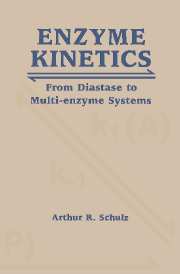Book contents
- Frontmatter
- Contents
- Preface
- Part One Basic steady state enzyme kinetics
- Part Two Enzyme reaction sequence
- 5 Multi-reactant enzymic reactions
- 6 Analysis of multi-reactant enzyme kinetics
- 7 Prediction of reaction sequence
- 8 Enzyme-catalyzed isotopic exchange
- 9 Kinetic isotope effect on steady state parameters
- 10 The effect of pH on enzyme kinetics
- Part Three Non-hyperbolic enzyme kinetics
- Part Four Control of multi-enzyme systems
- Part Five Solutions To problems
- Author index
- Subject index
8 - Enzyme-catalyzed isotopic exchange
Published online by Cambridge University Press: 23 November 2009
- Frontmatter
- Contents
- Preface
- Part One Basic steady state enzyme kinetics
- Part Two Enzyme reaction sequence
- 5 Multi-reactant enzymic reactions
- 6 Analysis of multi-reactant enzyme kinetics
- 7 Prediction of reaction sequence
- 8 Enzyme-catalyzed isotopic exchange
- 9 Kinetic isotope effect on steady state parameters
- 10 The effect of pH on enzyme kinetics
- Part Three Non-hyperbolic enzyme kinetics
- Part Four Control of multi-enzyme systems
- Part Five Solutions To problems
- Author index
- Subject index
Summary
Isotopes have been used extensively in enzymology to obtain answers to a number of different types of questions. Thus, isotopes have been used to gain insight into the mechanism of the catalytic reaction. Isotopes have also been used to locate the amino acids which constitute the active site or the allosteric site of enzymes. The following chapter will contain a discussion of how the isotope effect can be utilized to obtain information concerning the location of rate limiting steps in an enzyme sequence. The present chapter will be concerned with the study of the kinetics of isotopic exchange as a means of ‘fine tuning’ the understanding of the reaction sequence of an enzyme. It will be assumed in the discussion in this chapter that there is no significant isotope effect. That is, that the mass of the label isotope does not differ from the normal isotope significantly. Furthermore, it will be assumed that the concentration of the isotope is very small compared to the concentration of the normal isotope.
Isotopic exchange provides a means of obtaining an insight into the reaction sequence of an enzymic reaction which, in some instances, would be difficult or impossible to obtain by the methods described in the previous chapters. While the information available from analysis of isotopic exchange data can be very useful, the belief that these data are directly related to observations obtained in initial rate studies can be erroneous. This fact was pointed out by Boyer in his classic paper on isotopic exchange under equilibrium conditions. Most isotopic exchange experiments are conducted under equilibrium conditions, and most of the formal treatments have dealt with the equilibrium.
- Type
- Chapter
- Information
- Enzyme KineticsFrom Diastase to Multi-enzyme Systems, pp. 103 - 113Publisher: Cambridge University PressPrint publication year: 1994



